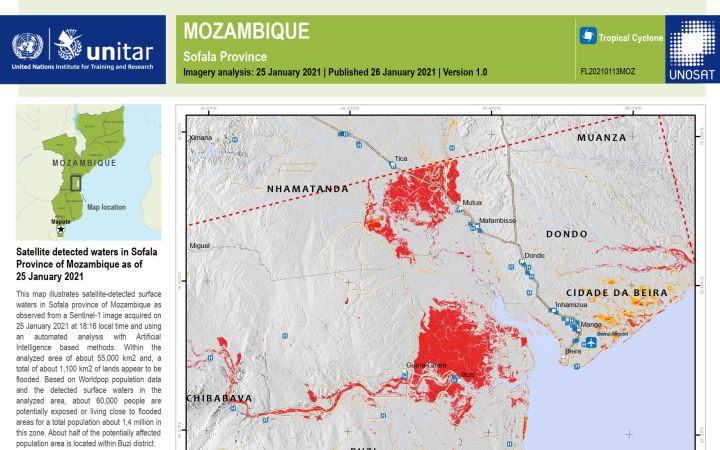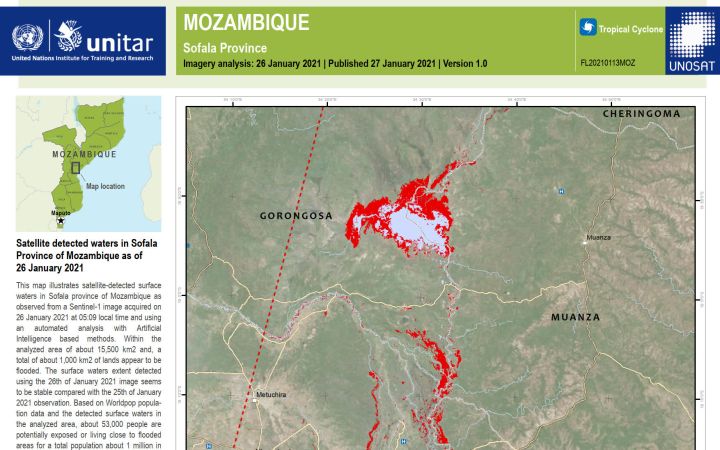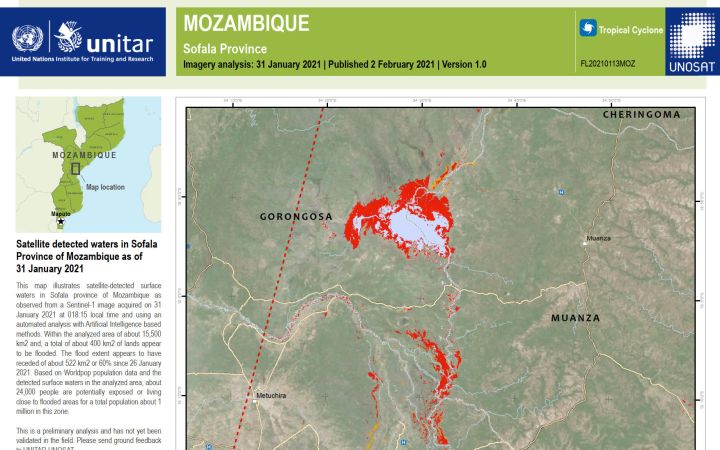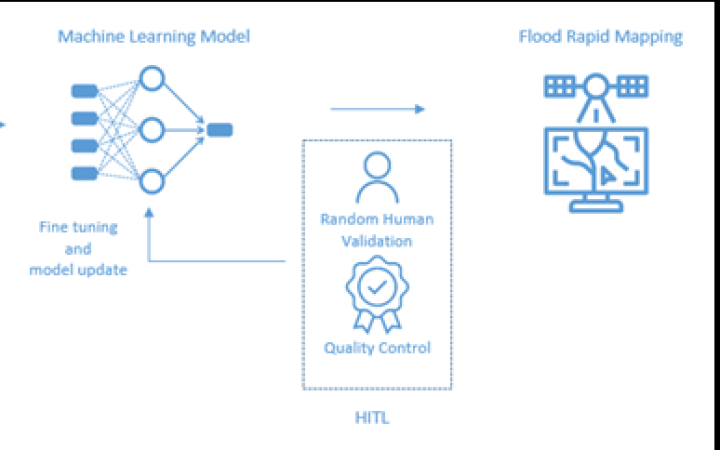Satellite image analysis for disaster mapping
13 April 2021, Geneva, Switzerland - Flooding is the most frequent type of disaster, affecting more than 2 billion people in the 20 years between 1998 and 2017 alone. When disaster hits, it is of vital importance to quickly know which areas have been affected in order to assess the potential damage and inform humanitarian relief efforts.
Within the United Nations Institute for Training and Research (UNITAR), the Operational Satellite Applications Programme (UNOSAT) supports teams on the ground to assess the impact of floods through its rapid mapping service. How this works is by having experienced analysts produce maps, reports, and data from satellite images to assess the extent of the damage.
On average, UNOSAT responds to 17 flood events per year. Maps of flooded regions are often turned around and delivered to relief efforts to support operations within 2 days. However, with the number of incidents on the rise, UNOSAT has been looking for ways to leverage technology, in particular AI, to automate some of these processes to produce ongoing results and free up time for analysts to perform other tasks.
Here is where the collaboration with UN Global Pulse, the UN Secretary-General’s digital innovation, real-time data, and AI initiative was born. Our teams have been closely working for the past several years to inject new technology into satellite image analysis. Flood mapping is one of the areas where our collaboration has unearthed fruitful results.
Experimenting with AI methodologies for rapid flood mapping
The current methods used by UNOSAT’s rapid mapping team are semi-automated, which means that even though some parts of the process are performed automatically, there remain many tasks that a geospatial analyst has to manually carry out. This limits the speed with which a map can be produced, and also the number of maps an individual analyst can produce at a time.
Computing and machine learning at scale now offer efficient automatic methods, which can improve the timeliness of response to a disaster. The creation of an end-to-end pipeline, whereby images of flood-prone areas are automatically downloaded and processed by machine learning algorithms to output disaster maps, could shorten the time needed for analysts to produce and deliver these maps. This would in turn increase the impact to end beneficiaries during humanitarian crises by allowing for the implementation of live streaming mapping services triggered by direct partner requests or automatic activations.
We, therefore, asked ourselves: How can we inject AI technology to speed up the process, while maintaining the high quality of maps?
Using UNOSAT’s extensive archive of historic flood maps, an AI algorithm was first trained to identify flooded areas. The training data consisted of satellite images collected from the ESA Copernicus Sentinel-1 satellites and the corresponding human-created flood maps. The dataset spanned 15 historic flood events from across nine countries. Once the algorithm was trained, it was tested in regions the model had never before been trained on. This was done to see how accurate the model could be in identifying flooded regions in a new environment. The AI model surpassed expectations by achieving accuracy scores of above 97%.
However, just because the model performed well in theory, doesn’t mean it would consistently perform the same in real-life scenarios, particularly as floods can occur all over the world and using the model in geographies which ‘look’ very different to those where it was trained may confuse it.
Putting the technology to the test in an operational setting
In January 2021, parts of central Mozambique were hit by Tropical Cyclone Eloise and experienced heavy rainfall. In order to understand which areas required humanitarian assistance, the United Nations Office for the Coordination of Humanitarian Affairs’s Regional Office for Southern and Eastern Africa (OCHA-ROSEA) contacted UNOSAT to rapidly map the extent of the flooding.
UNOSAT quickly activated its rapid mapping service. Satellite images were automatically accessed and UNOSAT’s analysts shared the results with the ROSEA team as soon as they were available. Amongst the satellite images sourced, the Sentinel-1 images available were fed into our model. The speed with which this model produces results was an advantage to monitor the spread of the floods in the area, as it can provide multiple updates when fed with several images.
This method had been preliminarily tested with the rapid mapping team during the monsoon season in South-East Asia over the summer of 2020, in particular for the monitoring of seasonal floods along the Brahmaputra river in Bangladesh. In general, to ensure that only high-quality maps are sent back to the teams on the ground, each map is checked by geospatial analysts. If the analysts notice mistakes made by automation they correct them and feed them back into the model to improve it going further. This is what is called a Human-in-the-loop approach (see infobox for more details). In the case of Mozambique, however, because our model performed so well, no manual corrections were needed.
Info Box: The human-in-the-loop approach
To make sure teams on the ground work with the highest quality maps, expert analysts regularly check and validate AI models.
When a request is received to produce a flood map the following procedure is carried out:
- A request is made to map a certain region - called the “Region of interest”. This initiates the automatic downloading of a satellite image (which can cover up to 400km² wide areas) covering the specific region;
- This image is then passed into the machine learning model which outputs a map of where the identified the flooded areas;
- A geospatial analyst then checks the model output to see if it is accurate - they look for flooded areas they think the model has missed or added by mistake;
- If the model output is correct, it is passed directly to the teams on the ground. If not, the necessary corrections are made before passing the results to the teams on the ground;
- When corrections are made, they are also used to ‘fine tune’ the model for future analyses.
It’s worth noting that AI models often struggle to perform well on images that look very different to those that they have been trained on. Fine-tuning can serve as a way to increase the variety of the number of regions the model has ‘seen’ before. In certain cases, such as regions where floods happen quite regularly, it can also be useful to develop models which are particularly tuned to that region and saved for later analysis. This pipeline is based on previous developments in our jointly created AI-powered tool PulseSatellite.
What have we learned and where do we go from here
For a while now, our teams have been working to include AI methodologies into flood map production for rapid response and the results are very positive. Of course, there have been multiple iterations and some challenges before success. Between UNOSAT and UN Global Pulse we also had to learn to work together, blending our work cultures and multiple time zones. This hasn’t always been easy, but innovation usually isn’t. You fail, but you learn, you fail but you adapt, you disagree but you find common ground.
Putting the technology to use in an operational setting helped increase the availability of analysts, since the production time for each is significantly shorter and the analysts’ expertise can be allocated to other tasks, without compromising on the quality of the analysis. We also discovered that in certain contexts, the model can perform well enough not to need human assistance.
Another important lesson learned is that of systems and the infrastructures needed to host these models. One thing we have learned in the course of our collaboration is that these infrastructures are sometimes hard to replicate from organization to organization and they require constant maintenance, upgrades, and all sorts of cloud computing power. We don’t think we’re there yet in terms of the perfect replicable infrastructure, or mechanism. PulseSatellite though is a start and we are learning from it.
Going forwards, we will continue to test the model in different locations as requests to map flooded regions continue to come in. To fully benefit from the time saved in using our AI approach, we plan to work on more ways to better include teams on the ground and end-beneficiaries into the mapping pipeline. For example, requests could be anticipated through news and social media monitoring, or through continuous downloading and processing of regions with high flood risks. We’re also planning to continue improving other applications where we’ve been using AI, like automatic roof counting or slum mapping. In the future, the hope is to use the technology more and more for different hazards, geographies, and needs.
- PulseSatellite, our collaboratively-designed AI-powered satellite image analysis tool
- Our academic paper presenting our flooding models
Co-written by UNOSAT & UN Global Pulse (Felicia Adriana Vacarelu, Communications Lead, UN Global Pulse, & Joseph Aylett-Bullock, Data Scientist and Researcher, UN Global Pulse)





